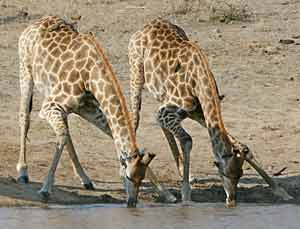Contact Details: Scotch Macaskill, Dirt Road Traders, Currys Post Road, Howick, KwaZulu-Natal, South Africa. Tel: +27 (0)82 578 2329. Privacy: Your privacy is guaranteed. See our Privacy Policy for more. This site accepts advertising and other forms of compensation - see Disclosure and Advertising for details. Site updated: 2022. Copyright © 2002 - 2022 Scotch Macaskill

| ||||||||||
|
||||||||||
|
SEE ALL
|
The Giraffe is Truly Uniqueby Roddy SmithOne of the mysteries of the Lower Zambezi National Park in Zambia is that neither giraffe nor
wildebeest have ever been recorded there, although the habitat is entirely suitable and both occur to the
north, south and west.
Among the theories as to why the giraffe is absent are that they were unable to get down the escarpment, and that the valley floor becomes too soggy for them in the wet season; neither is entirely convincing and neither explains the absence of wildebeest, which as far as I know are found everywhere else that plains zebra occur. Whatever the reason it is a pity; the giraffe in particular is an African icon, instantly recognised around the world. This is a truly unique animal; the genus contains only a single species, Giraffa camelopardalis, but as usual the boffins differ on how many sub-species there are – nine are generally accepted but opinions range from one to 13. These inter-breed freely in captivity but genetic testing indicates that several of these sub-species have been reproductively isolated for thousands of years and do not inter-breed in the wild even though there are no natural obstacles keeping them apart. The only other member of the exclusively African family giraffidae is the jungle-dwelling okapi. World's Tallest Animal The giraffe is the world's tallest animal, with males reaching around 5.5m (18ft) high. But it's not the highest feeding – the elephant can stretch higher with its trunk. Quite surprisingly the giraffe's long neck has only seven vertebrae, the same number as most mammals including man, but they are very elongated and have very flexible joints between them. A particularly flexible joint where the spine joins the skull allows it to stretch its head into and even past the alignment of the neck, and it uses its very long, tough and flexible tongue and mobile lips to strip off foliage. The tongue seems impervious to thorns and is also used to clean its eyes and ears. (See also How Giraffes Sort Leaves from Thorns).
The huge heart (about 60cm long, weighing about 10kg and with muscular walls several centimetres thick) generates the highest blood pressure of any mammal, necessary to pump blood up to the brain against gravity. The other side of the coin is that this pressure needs to be controlled to stop blood flooding to the head when it is lowered, and to the feet all the time. Ingenious Control System In one of nature's more ingenious control systems, elastic carotid arteries help pump blood up but expand to reduce pressure when the head goes down, a network of capillaries (the rete marabilis or miracle net) at the top of the carotid absorbs and slows blood flow, while one-way valves in the jugular veins prevent the blood running back down into the lowered head due to gravity. In the lower legs where there are no elevation changes to vary the blood pressure the flow is restricted by less elastic arteries and an exceptionally tight skin (the giraffe's skin has been studied by NASA in research into gravity suits). These are not the giraffe's only unique features. It starts life with something of a bump, being dropped on its head from a considerable height at birth. Born with Horns It is the only animal born with horns, and even these are unique. Known as ossicones, at birth they are not attached to the skull, being cartilaginous pegs folded flat under the skin. They soon assume their erect position and while they grow slowly from the base they ossify (turn to bone) from the top down and eventually fuse with the parieatal bones of the skull. As male giraffes age calcium deposits can form knobs in three other places on the skull so that in extreme cases they have five horns; the male giraffe uses his skull as a big knobbly club to fight with other males. As a result the ends of males' horns are bald while females' are tufted with hair – a good way to tell sexes apart.
There are two theories of how the giraffe's neck evolved. (Creationists don't have to wonder about this
stuff – they just say giraffes were made like that.) The traditional view was that longer-necked giraffes
survived hard times better because they could reach higher to feed; a more recent theory is that males
with longer necks become dominant because of the advantage it gives them when fighting.
We are all familiar with images of giraffes drinking (right) and they will certainly do so when they can, but they can survive long periods without drinking (even longer than camels), getting enough water from dew and the foliage they eat. They also require less sleep than almost any other mammal, averaging less than two hours out of 24. Roddy Smith is a wildlife conservationist and safari guide based in the Lower Zambezi National Park, Zambia. Images © Scotch Macaskill Return to Wildlife Articles |
|||||||||
|
|
||||||||||
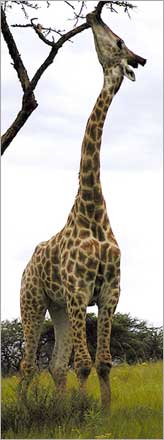
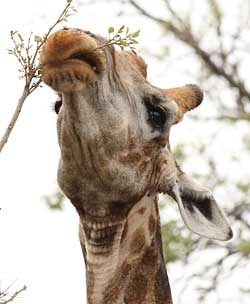
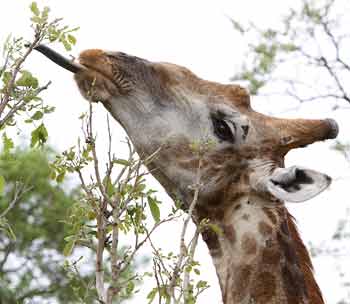
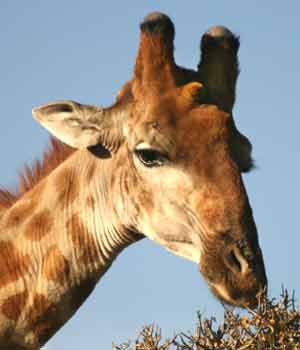 Male giraffe with bald horn tips
Male giraffe with bald horn tips
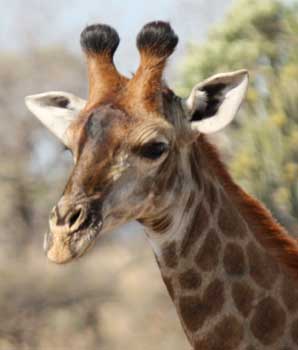 Female giraffe with tufted horn tips
Female giraffe with tufted horn tips
